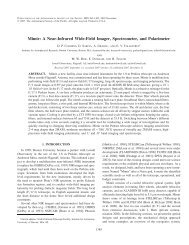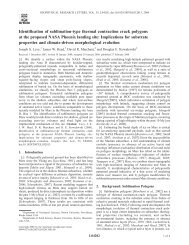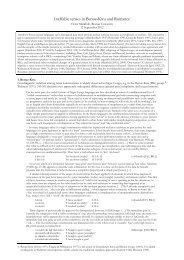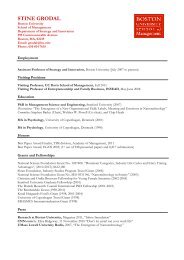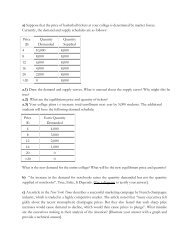Intertemporal Substitution and Recursive Smooth Ambiguity ...
Intertemporal Substitution and Recursive Smooth Ambiguity ...
Intertemporal Substitution and Recursive Smooth Ambiguity ...
Create successful ePaper yourself
Turn your PDF publications into a flip-book with our unique Google optimized e-Paper software.
Segal (1987, 1990) <strong>and</strong> Seo (2009). Segal uses the anticipated utility model <strong>and</strong> considersobjective lotteries, while the Ellsberg paradox is often viewed as a phenomenon associatedwith subjective uncertainty. Seo does not provide a formal definition of ambiguity aversion<strong>and</strong> characterizations of ambiguity attitude. We provide such an analysis <strong>and</strong> characterizethe link between ambiguity aversion <strong>and</strong> reduction of compound lotteries. Our result thatambiguity aversion is identical to risk aversion in the first stage is similar to Theorem 5in Ergin <strong>and</strong> Gul (2009) who refer to risk aversion in the first stage as second-order riskaversion.Maccheroni, Marinacci, <strong>and</strong> Rustichini (2006b) provide a dynamic extension of the staticvariational model of ambiguity developed by Maccheroni, Marinacci, <strong>and</strong> Rustichini (2006a).The static variational model includes multiple-priors model <strong>and</strong> the multiplier preferencemodel of Hansen <strong>and</strong> Sargent (2001) as special cases. The dynamic extension does notseparate intertemporal substitution from attitude toward risk or ambiguity. Variationalpreferences are also subject to the limitation concerning the separation of ambiguity fromambiguity attitude.Our model is also related to the literature on recursive utility under risk or uncertainty(Chew <strong>and</strong> Epstein (1991), Epstein <strong>and</strong> Zin (1989), Klibanoff <strong>and</strong> Ozdenoren (2007), Kreps<strong>and</strong> Porteus (1978), <strong>and</strong> Skiadas (1998)). This literature does not deal with ambiguity. Inthe framework of Klibanoff <strong>and</strong> Ozdenoren (2007) or Skiadas (1998), preferences depend onthe filtration. Unlike their framework, we take the filtration as given <strong>and</strong>, thus, cannot makecomparisons of representations across filtrations.<strong>Recursive</strong> utility models allow for preferences for the timing of the temporal resolutionof uncertainty. As is well known in the literature on recursive expected utility preferences, anonlinear time aggregator is needed to permit nonindifference to the timing of the temporalresolution of uncertainty. Strzalecki (2009) shows that even without a nonlinear aggregator,or with st<strong>and</strong>ard discounting, most dynamic models of ambiguity aversion (including themodels discussed above) result in timing nonindifference. In particular, decision makerswith such preferences prefer earlier resolution of uncertainty. The only model of ambiguityaversion that exhibits indifference to timing is the multiple-priors utility model. Our paperdoes not study this issue. Presumably, Strzalecki’s analysis can be applied to our setting.Finally, like most papers in the literature on dynamic models, we follow a recursiveapproach <strong>and</strong> maintain dynamic consistency. This approach is normative appealing <strong>and</strong>computationally simple in applications because the usual dynamic programming method canbe applied. This approach typically shares the drawback of lacking a ‘reduction’ or ‘closure’31



